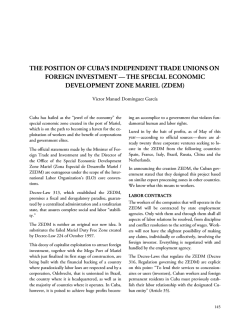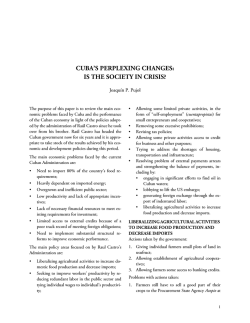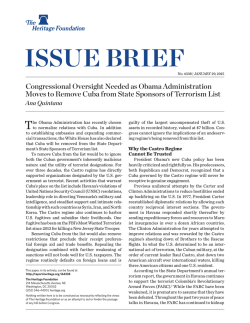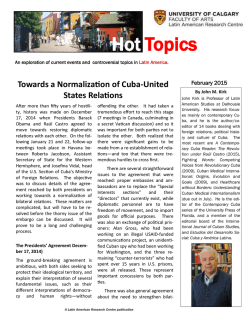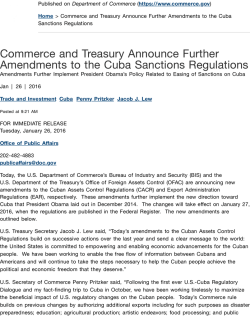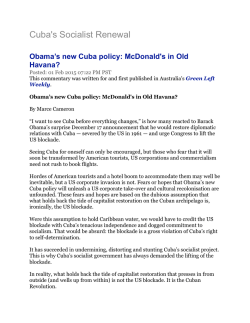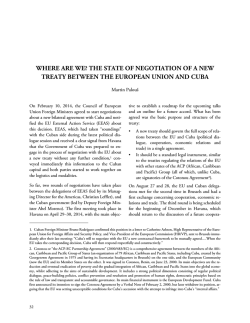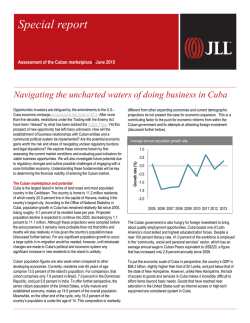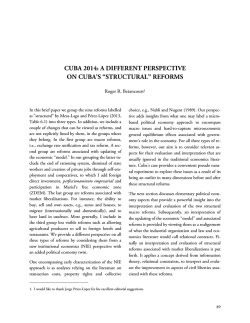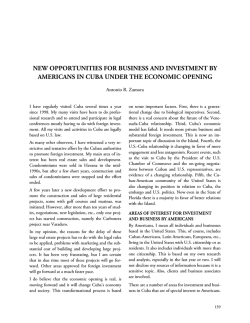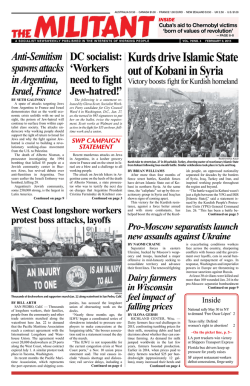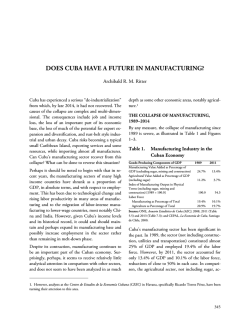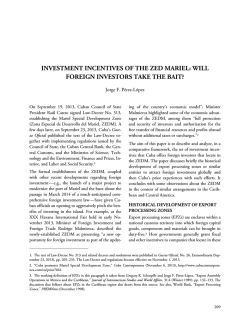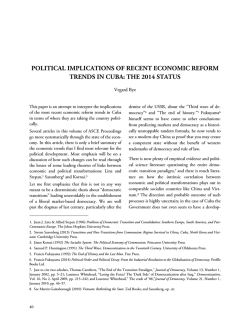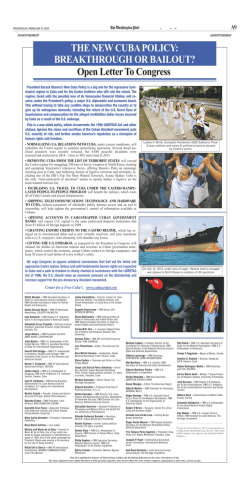
Jorge Perez-Lopez - Association for the Study of the Cuban Economy
A SIMPLE GROWTH MODEL OF THE CUBAN ECONOMY Carlos Seiglie The objective of this paper is to analyze certain stylized facts of the Cuban economy. The first is the recent policy by the Cuban government to allow the development of a private sector alongside the state sector. The second is the push towards greater industrialization with the development of the port of Mariel. The third is to explore the effects of a decline in fertility in Cuba on its prospects for economic development. Finally, it appears that Cuba's model will consist of closing inefficient state companies and permitting the existence of only a few to remain in order to encourage competition between them and therefore efficiency. The literature on the determinants of economic growth in centrally planned economies is sparse. Notable contributions to the literature include Roberts and Rodriguez (1997) and Bajona and Locay (2009). This paper differs from theirs in that it models economic growth within a two sector model of capital accumulation. It follows in the vein of Uzawa (1962, 1964) of a Solow-Swan type model for the sake of simplicity. THE MODEL We assume two sectors in the economy, a private sector which we denote with subscript p and the state sector which we denote by s. In this economy, labor and capital are assumed to be freely mobile between sectors. The production functions in both sectors are assumed to exhibit constant returns to scale. The key difference between this model and other two-sector models is that competition is assumed to exist in the private sector, but the state sector is a monopoly. In other words, we assume that the Cuban government does not permit entry into the state sector but does allow entry and exit from the private sector. This is in fact currently the case since the Cuban government has licensing requirement for entry into the private sector, while not allowing entry into the state sector. It should be noted that this policy of restricting entry into the state sectors will have consequences for Cuba's trade policy in the sense that the Cuban government will have to restrict international trade (imports) in order to maintain the monopoly position of the state sector. Without the Cuban government restricting trade, imports of goods which compete directly with state produced goods will reduce the profitability of government industries, and therefore, government revenues. We can explore this problem in an extension of the model we present by permitting the economy to be open to international trade. Let the labor-augmented production functions for both sectors be: Yp Fp K p , Ap L p (1) Ys Fs K s , As Ls (2) where K p , L p , K s , Ls are the amounts of capital and labor employed in each sector and Y p , Ys be the sectoral output of the private and state sector, respectively. We assume for simplicity that the labor augmenting technological progress, Ai 1 . These production functions, as mentioned, are characterized by constant return scale, are twice continuously differentiable, satisfy the Inada conditions with 247 Cuba in Transition • ASCE 2014 F P F Ps 1 s s s rs Ps Fs K s Yi 2Yi Yi 2Yi , 0, 2 0 0, 2 0 for i=p,s K i K i Li Li Given constant returns to scale, the production functions can be written as a function of the capital-labor ratio in each sector, (4). ki as given by equations (3) and yp f p kp (3) ys f s k s (4) where yi Yi Li and ki Ki Li . Note that the first derivative of yi is positive while the second derivative is negative, i.e., fi 0, fi 0 . In the competitive private sector, profit maximization leads to: Pp Pp where Fp L p Fp K p Pp is the price for the state sector good and ws and rs are the wage and cost of capital in the state sector. This can be rewritten as: 1 F Ps 1 s ws s Ls (7) 1 F Ps 1 s rs s K s (7’) where s is the elasticity of demand for the good produced in the state sector A monopolist will hire labor and capital to the point where the marginal revenue product of the additional factor hired is just equal to the cost of the factor, in this case the wage and cost of capital, respectively. wp (5) rp (5’) equalized. In other words, wp ws and rp rs . We assume all factors are fully employed so that rp , the wage and cost of capital in the private sector. This is the standard condition for profit maximization, which states that a firm in a competitive industry will hire a factor of production until the value of the marginal product (as given by the left-hand side) is equal to the cost of hiring the factor of production. For the state sector that is a monopoly, the profit maximizing conditions are: F P F Ps 1 s s s ws Ps Fs Ls 248 Ps With free mobility of both factors of production, if wages or the cost of capital are higher in the private sector than in the state sector, individuals will leave the state sector and enter the private sector. This will continue until wages and the cost of capital are is the price for the private sector good and w p and where (6’) (6) K p Ks K (8) and L p Ls L . (8’) Finally, we assume that labor does not save and capital does not consume. Therefore, the income to capital in the economy is spent on purchasing the state sector’s output, while the income of workers in the economy is spent purchasing the product of the private sector. An example of this assumption for Cuba would be that the income earned by workers in the overall economy is spent eating in paladares and other private establishments, while the income from capital, which for the most part goes to the Cuban gov- A Simple Growth Model of the Cuban Economy ernment is reinvested into the state sector, for example, by them purchasing new capital goods. Therefore, PY s s rs K (9) PpYp ws L (9’) where K and L are the total amounts of capital and labor in the economy. We can express equations (8) and (8’) in per capita terms so that: l p k p ls k s k (10) l p ls 1 (11) where li Li L ing the left-hand sides by Li Li and rearranging, we get 1 l s y s 1 f sk s 1 l y p P 1 f s f s k s s lp s where P Ps Pp (14) . Since we are exploring the growth of the economy, we must introduce dynamics, in particular population growth and the growth of the capital stock. The rate of population growth over time, which we de- . Since the marginal product of labor is given Fi by f i ki f i ki Li uct of capital by Dividing both sides of the above by L and multiply- note by n, is given by and the marginal prodwe let Fi fi , the wage-rental ratio K i n L L dL L dt where . If be the rate of capital depreciation, then the rate of capital accumulation over time, dK K dt is given by is: f i ki ki f i ki for i=p,s and w s rs (12) . Finally, equations (9) and (9’) can be rewritten as 1 PY fs K s s Ps 1 s (13) 1 PpYp Ps 1 f s f sk s L . s (13’) 1 K 1 f s K K s . (15) Let us explain the development of equation (15) further. The first term on the right hand side is the amount invested by the Cuban government in the form of purchases of new capital goods as given by equation (13). From this amount, we subtract the amount of capital depreciated during that time period to arrive at the rate of net capital accumulation. Furthermore, this can be expressed in terms of the rate of change of the capital-labor ratio over time as 1 k 1 f sk n k . s (15’) 249 Cuba in Transition • ASCE 2014 A steady-state capital-labor ratio or balanced growth path is one where k 0 or 1 * 1 fs k n s where tio. k* (16) denotes the steady-state capital labor ra- From the above we get, (17) Given the parameters on the right-hand side of equation (17), k * is determined. As a result, by equation (12) the wage-rental ratio, is uniquely determined and therefore, so is k p and ks 1. From equation (17) we can derive several implications about the Cuban economy. First, note that if s =∞, i.e., if Cuba’s state sector were allowed to be f s k * ( n ) . n 1 1 s n . much lower capital-labor ratio than otherwise and as a result, Cuba will experience a lower level of per capita income. To prevent the continuation of this trend, it is important that Cuba addresses institutional changes in the ownership structure of firms and in particular, encourages the development of well-functioning capital markets (stock and bond markets) which will allow for the removal and replacement of managers in firms based upon their performance. Management has to have a long term horizon that makes the appropriate investments in plant and equipment. This has not been the case, and as a result we observe in Cuba a capital stock that depreciates at a faster than necessary rate. We explore some of these results graphically in Figure 1. The downward sloping line is the marginal product of capital as given by the left-hand side of the equation 17. With an economy where the state sector is a monopoly, the equilibrium capital-labor Having the state sector be a monopoly results in f s k * An interesting finding is that since the growth of Cuba’s population, n, has declined, by equation (18) we can see that the steady-state capital-labor ratio is greater that it would be if the population was growing more rapidly. As a result, we should expect that the per capita income of Cuba to be larger in the future than otherwise. A distressing implication from the model is that the rate of depreciation of Cuba’s capital stock which we measure by , will lead to a n f s k * 1 1 s competitive, then ture implies a lower per capita income for Cuba than otherwise. (18) Since the left-hand side of equation (18) is decreasing in the capital-labor ratio, the steady state capital-labor ratio, k * under a monopoly in the state sector is smaller than it would be if the Cuban government structured it as a competitive sector. Since per capita income is increasing in the capital-labor ratio, this smaller capital- labor ratio under the current struc- ratio in the steady-state is given by k * . On the other hand, if the state permitted competition in this sector than the equilibrium capital-labor ratio is given by the larger k ** . With this larger capital-labor ratio, per capita income in Cuba would be larger than otherwise. As for the effects of population growth and the rate of depreciation of capital, we can see that increases in either will result in the horizontal line shifting upwards and as a result, Cuba’s capital-labor ratio and per capita income decline. 1. We can explore other issues regarding the implication of which sector is more capital intensive in later research. 250 A Simple Growth Model of the Cuban Economy Finally, let me present a numerical example. Suppose, ys k s and that the rate of population growth is 1%, the rate of capital depreciation is 4% and the elasticity of demand for the state sector product is -2. By equation (17), 1/3 1 1 s k* 3 n 3/2 so that k * is equal to 6.1 and wages of workers would be 1.20. Instead, if the state sector was competitive and the elasticity was therefore infinite, the new capital-labor ratio would be 17.2 and wages of workers would increase to 1.68. ratio than current policies of allowing the state sector to be a monopoly. Not only would economic development be spurred, but the wages of workers would be increased. Furthermore we show that policies which reduce the rate of capital depreciation in Cuba will lead to higher per capita income for the population. The government must create institutions, including well-functioning capital markets that create incentives for efficient production. Finally, if these policies are followed, Cuba’s low fertility rate will lead higher levels of per capita income for the country. Figure 1. CONCLUSION This paper has presented a two sector model of the Cuban economy to explore how different economic policies by the Cuban government could affect long term levels of per capita income. We showed that policies that encourage competition with the state sector will lead to a higher steady-state capital-labor REFERENCES Bajona, C. and Luis Locay. 2009. “Entrepreneurship and Productivity: The Slow Growth of the Planned Economies,” Review of Economic Dynamics, 12(3), pp. 503-522. Roberts, Bryan and Alvaro Rodriguez. 1997. “Economic Growth under a Self-Interest Planner and Transition to a Market Economy,” Journal of Comparative Economics, 24, pp. 121-139. Uzawa, Hirofumi. 1962. “On a Two-Sector Model of Economic Growth” Review of Economic Studies, 29, pp. 40- 47. Uzawa, Hirofumi. 1964. “Optimal Growth in a Two-Sector Model of Capital Accumulation,” Review of Economic Studies, 31, pp. 1-25. 251
© Copyright 2026
